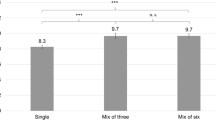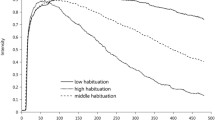Abstract
Objectives: To ensure safety and health the avoidance of adverse chemosensory effects is essential at workplaces where volatile chemicals are used. The present study describes psychophysical approaches that provide information for the evaluation of such effects. Methods: By means of a modified staircase procedure the odor (OT) and irritation thresholds (IT) of 15 irritants were determined. These basic chemosensory properties, confining the chemosensory effect range, were investigated in a random sample of 144 persons stratified for gender and age. Those irritants exhibiting high chemosensory potency were selected for the second psychophysical part of the study. Forty-eight persons, again stratified for gender and age, rated the intensity of 13 trigeminal and olfactory perceptions elicited by nine ascending concentrations of the irritants, ranging from the odor to the irritation threshold of the respective substances. Results: Across the investigated chemicals the transition from concentrations eliciting pure olfactory stimulation (OT) to trigeminal stimulation (IT) differed markedly. The carboxylic acids yielded narrow ranges from odor to irritation thresholds, while for the amines (cyclohexylamine, dimethylamine, and trimethylamine) and the esters (ethyl formate and ethyl acetate) these ranges were somewhat wider. The two chemosensory thresholds of ethyl acrylate and ammonia were farthest from each other. Gender and age had only weak impact on the chemosensory thresholds. At present, the results of the intensity ratings could be given for six substances. Among them, the rated pungency for cyclohexylamine, formic acid, and ethyl acetate increased strongest across the nine applied concentrations. Conclusions: By means of these psychophysical approaches a diverse class of chemicals can be described and compared with respect to their chemosensory potency. This information can be used twofold (a) for the evaluation of existing studies reporting sensory irritations and (b) for the design of experimental exposure studies.


Similar content being viewed by others
References
Amoore JE, Hautala E (1983) Odor as an aid to chemical safety: odor thresholds compared with threshold limit values and volatilities for 214 industrial chemicals in air and water dilution. J Appl Toxicol 3:272–290
Cometto-Muniz JE, Cain WS (1990) Thresholds for odor and nasal pungency. Physiol Behav 48:719–725
Cometto-Muniz JE, Cain WS (1994) Perception of odor and nasal pungency from homologous series of volatile organic compounds. Indoor Air 4:140–145
Cometto-Muniz JE, Cain WS (1995) Relative sensitivity of the ocular trigeminal, nasal trigeminal and olfactory systems to airborne chemicals. Chem Senses 20:191–198
Cometto-Muniz JE, Cain WS (1998) Trigeminal and olfactory sensitivity: comparison of modalities and methods of measurement. Int Arch Occup Environ Health 71:105–110
Cometto-Muniz JE, Cain WS, Abraham MH (1998) Nasal pungency and odor of homologous aldehydes and carboxylic acids. Exp Brain Res 118:180–188
Cometto-Muniz JE, Cain WS, Hiraishi T, Abraham MH, Gola JM (2000) Comparison of two stimulus-delivery systems for measurement of nasal pungency thresholds. Chem Senses 25:285–291
Cometto-Muniz JE (2001) Physicochemical basis for odor and irritation potency of VOCs. In: Spengler JD, Samet JM, McCarthy JF (eds) Indoor air quality handbook. McGraw-Hill, NY, pp 20.1–20.21
Cometto-Muniz JE, Cain WS, Abraham MH, Gola JM (2002) Psychometric functions for the olfactory and trigeminal detectability of butyl acetate and toluene. J Appl Toxicol 22:25–30
Dalton P, Wysocki CJ, Brody MJ, Lawley HJ (1997) The influence of cognitive bias on the perceived odor, irritation and health symptoms from chemical exposure. Int Arch Occup Environ Health 69:407–417
Dalton P (1999) Cognitive influences on health symptoms from acute chemical exposure. Health Psychol 18:579–590
Dalton P (2003) Upper airway irritation, odor perception and health risk due to airborne chemicals. Toxicol Lett 140–141:239–48
Dalton PH, Dilks DD, Banton MI (2000) Evaluation of odor and sensory irritation thresholds for methyl isobutyl ketone in humans. Aihaj 61:340–350
Devos M, Patte F, Rouault J, Laffort P, Van Gemert LJ (1990) Standarsized human olfactory thresholds. IRL Press, Oxford
DFG (2004) List of MAK and BAT values. Wiley-VCH, Verlag, GmbH, Weinheim
Dick RB, Ahlers H (1998) Chemicals in the workplace: incorporating human neurobehavioral testing into the regulatory process. Am J Ind Med 33:439–453
Doty RL, McKeown DA, Lee WW, Shaman P (1995) A study of the test-retest reliability of ten olfactory tests. Chem Senses 20:645–656
Edling C, Lundberg P (2000) The significance of neurobehavioral tests for occupational exposure limits: an example from Sweden. Neurotoxicology 21:653–658
Emmen HH, Muijser H, Arts JH, Prinsen MK (2003) Human volunteer study with PGME: eye irritation during vapour exposure. Toxicol Lett 140–141:249–259
Ernstgard L, Gullstrand E, Lof A, Johanson G (2002) Are women more sensitive than men to 2-propanol and m-xylene vapours? Occup Environ Med 59:759–767
Ernstgard L, Sjogren B, Warholm M, Johanson G (2003) Sex differences in the toxicokinetics of inhaled solvent vapors in humans 2. 2-propanol. Toxicol Appl Pharmacol 193:158–167
Frasnelli J, Hummel T (2005) Intranasal trigeminal thresholds in healthy subjects. Environ Toxicol Pharmacol 19:575–580
Green BG, Dalton P, Cowart B, Shaffer G, Rankin K, Higgins J (1996) Evaluating the ‘Labeled Magnitude Scale’ for measuring sensations of taste and smell. Chem Senses 21:323–334
Hellman TM, Small FH (1974) Characterization of the odor properties of 101 petrochemicals using sensory methods. J Air Pollut Control Assoc 24:979–982
Hempel-Jorgensen A, Kjaergaard SK, Molhave L, Hudnell KH (1999) Sensory eye irritation in humans exposed to mixtures of volatile organic compounds. Arch Environ Health 54:416–424
Hudnell HK, Otto DA, House DE, Molhave L (1992) Exposure of humans to a volatile organic mixture. II. Sensory. Arch Environ Health 47:31–38
Hummel T, Sekinger B, Wolf SR, Pauli E, Kobal G (1997) ‘Sniffin’ sticks’: olfactory performance assessed by the combined testing of odor identification, odor discrimination and olfactory threshold. Chem Senses 22:39–52
Kiesswetter E, Blaszkewicz M, Vangala RR, Seeber A (1994) Acute exposure to acetone in a factory and ratings of well-being. Neurotoxicology 15:597–601
Kobal G, Van Toller S, Hummel T (1989) Is there directional smelling? Experientia 45:130–132
Laing DG (1983) Natural sniffing gives optimum odour perception for humans. Perception 12:99–117
Laska M, Distel H, Hudson R (1997) Trigeminal perception of odorant quality in congenitally anosmic subjects. Chem Senses 22:447–456
Radil T, Wysocki CJ (1998) Spatiotemporal masking in pure olfaction. Ann NY Acad Sci 855:641–644
Ruth JH (1986) Odor thresholds and irritation levels of several chemical substances: a review. Am Ind Hyg Assoc J 47:A142–A151
Schaper M (1993) Development of a database for sensory irritants and its use in establishing occupational exposure limits. Am Ind Hyg Assoc J 54:488–544
Shusterman D (2001) Odor-associated health complaints: competing explanatory models. Chem Senses 26:339–343
Shusterman D (2002) Review of the upper airway, including olfaction, as mediator of symptoms. Environ Health Perspect 110(Suppl 4):649–653
Shusterman D, Murphy MA, Balmes J (2003) Differences in nasal irritant sensitivity by age, gender, and allergic rhinitis status. Int Arch Occup Environ Health 76:577–583
Smeets M, Dalton P (2002) Perceived odor and irritation of isopropanol: a comparison between naive controls and occupationally exposed workers. Int Arch Occup Environ Health 75:541–548
Smeets MA, Maute C, Dalton PH (2002) Acute sensory irritation from exposure to isopropanol (2-propanol) at TLV in workers and controls: objective versus subjective effects. Ann Occup Hyg 46:359–373
Sundblad BM, Larsson BM, Acevedo F, Ernstgard L, Johanson G, Larsson K, Palmberg L (2004) Acute respiratory effects of exposure to ammonia on healthy persons. Scand J Work Environ Health 30:313–321
van Thriel C, Seeber A, Kiesswetter E, Blaszkewicz M, Golka K, Wiesmuller GA (2003a) Physiological and psychological approaches to chemosensory effects of solvents. Toxicol Lett 140–141:261–271
van Thriel C, Wiesmuller GA, Blaszkewicz M, Golka K, Kiesswetter E, Seeber A, Bachert C (2003b) Intranasal effects in chemically sensitive volunteers: an experimental exposure study. Environ Toxicol Pharmacol 14:129–137
van Thriel C, Kiesswetter E, Schaper M, Blaszkewicz M, Golka K, Seeber A (2005) An integrative approach considering acute symptoms and intensity ratings of chemosensory sensations during experimental exposures. Environ Toxicol Pharmacol 19:589–598
Wysocki CJ, Dalton P, Brody MJ, Lawley HJ (1997) Acetone odor and irritation thresholds obtained from acetone-exposed factory workers and from control (occupationally unexposed) subjects. Am Ind Hyg Assoc J 58:704–712
Acknowledgments
The authors would like to thank all participants as well as the staff of the involved working groups for conducting the threshold assessments and the extensive chemical analyses. The study was funded by the Hauptverband der gewerblichen Berufsgenossenschaften (HVBG).
Author information
Authors and Affiliations
Corresponding author
Rights and permissions
About this article
Cite this article
van Thriel, C., Schäper, M., Kiesswetter, E. et al. From chemosensory thresholds to whole body exposures—experimental approaches evaluating chemosensory effects of chemicals. Int Arch Occup Environ Health 79, 308–321 (2006). https://doi.org/10.1007/s00420-005-0057-4
Received:
Accepted:
Published:
Issue Date:
DOI: https://doi.org/10.1007/s00420-005-0057-4




